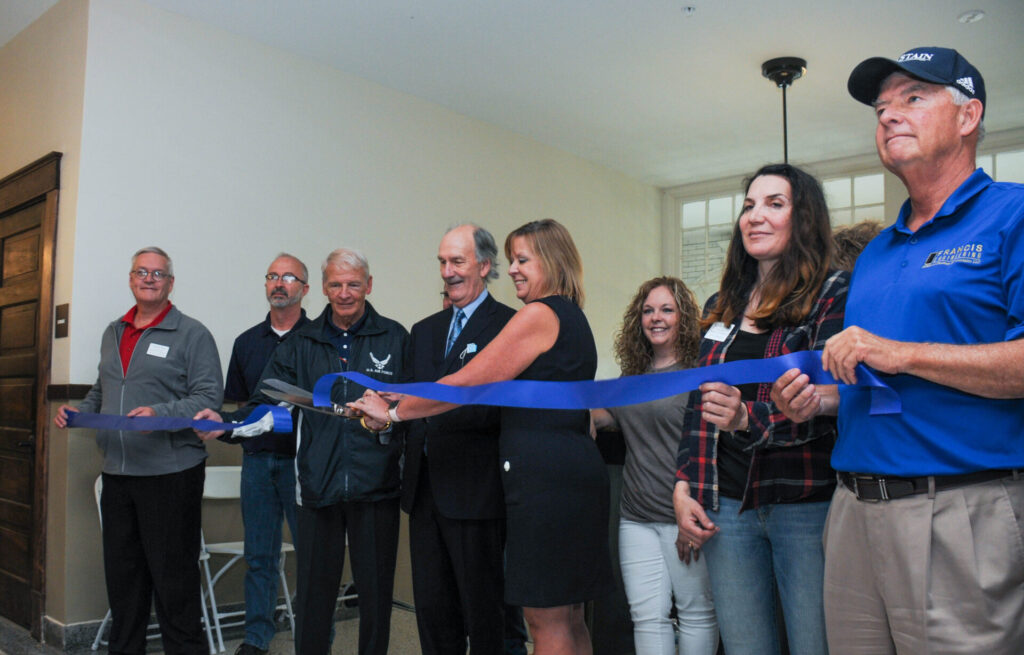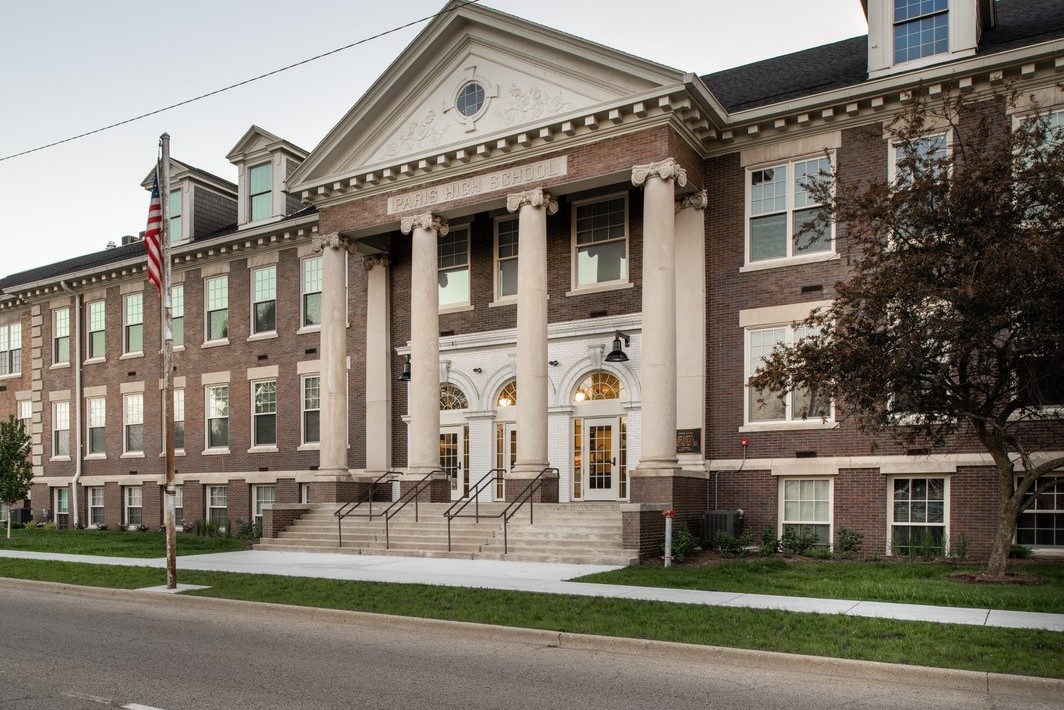(Pictured:LHDC led the adaptive reuse of the 100-year-old former Paris High School, converting it into low-income senior housing. The project won a Landmarks Illinois Richard H. Driehaus Foundation Preservation Award in 2021.)
MAY 25, 2023
(This article originally appeared in our May 2023 edition of our print newsletter, The Arch. Read The Arch here. )

Jayne Lourash is the Executive Director of the Laborers’ Home Development Corporation (LHDC), a nonprofit affordable housing development company affiliated with the Laborers’ International Union, Midwest Region. She led the organization’s first-ever adaptive reuse project, the Tiger Senior Apartments in Paris, Illinois, which won a Landmarks Illinois Richard H. Driehaus Foundation Preservation Award in 2021. Below, Lourash, who also serves on Landmarks Illinois’ Board of Directors, talks about how reusing historic places can help alleviate the housing shortage in Illinois and beyond.
LANDMARKS ILLINOIS: What drew you to the Paris High School, since this was your first adaptive reuse project?
JAYNE LOURASH: LHDC already had 92 units of multi-family affordable housing in Paris. These were new construction projects built in two phases; 50 units completed in 2011 and 42 units completed in 2015. During this process, we developed a relationship with the Mayor of Paris, Craig Smith. When construction of the new Paris High School was complete and the old high school was vacated, Mayor Smith came directly to LHDC and said, “We need affordable senior housing in Paris. What do you think about doing a rehab of the old high school?” So, we jumped in feet first.
LI: What challenges did you encounter doing an adaptive reuse of the Paris High School?
JL: Among the challenges we faced at Tiger Senior Apartments were our sustainable design goals and the National Green Building Standard (NGBS) certification. We incorporated many sustainable design features including insulation, mechanical systems, lighting and plumbing, all while maintaining the historic integrity of the building interior. This required some creative design solutions, all achieved with help from our architect Heidi Wang at WJW.
Another major challenge was the inclusion of new exterior wall insulation to meet current energy code requirements. We were limited on the allowable depth for new furring, and there were some historic curved window jambs and heads that needed to be maintained. After much discussion with the Illinois State Historic Preservation Office and the National Park Service (NPS), we developed a detail for the new insulation. We were also able to recreate the curved jamb conditions by using a specialized drywall trim component. This detail is now being recommended by NPS on other projects currently undergoing design review.

(Pictured: Jayne Lourash (middle) at the ribbon cutting for Tiger Senior Apartments development in Paris, Illinois. Courtesy Jayne Lourash.)
LI: We included affordable housing in Cairo on our Most Endangered list this year. The Department of Housing and Urban Development is proposing to demolish existing affordable housing in Cairo. What do you think is preventing HUD from adapting nearby existing historic buildings to provide housing for the displaced residents?
JL: The biggest hurdles, in my opinion, are the funding/cost factor and the timelines. Creating and preserving affordable housing is costly, and with costs increasing across the board, it is getting even more difficult to get the funding needed to get these projects over the finish line.
We all know that there is an increased need for affordable housing not only across the state of Illinois, but the entire country. When it takes a minimum of one year to receive funding approval (the Low-Income Housing Tax Credit has one application round annually) and then maybe 8-10 months to close a deal (provided all the gap financing is in place) and then a 12-18 month construction timeline, it deters community leadership from going that route. Unfortunately, I do not see a way of shortening the timeline.
If we can get funding agencies to coordinate efforts and work together to streamline some of the process, it would greatly help in these efforts. And, obviously, if there was a way to reduce the costs of a historic building rehab, that would make these projects more appealing to entities like HUD and also to private developers.
LI: Do you believe there is an opportunity to increase the affordable housing supply in Illinois through adaptive reuse?
JL: Yes. There is a wide variety of historic eligible buildings across the state that would make great candidates for an affordable housing adaptive reuse project. Developers should be looking at vacant affordable housing developments, old school buildings, former tuberculosis sanitariums, industrial buildings, small hospital buildings, the list goes on. Adaptive reuse of historic buildings not only preserves a community’s history, it is a clear definition of sustainability.
LI: What policies and practices need to change for it to become easier to adapt existing buildings into affordable housing?
JL: Some of the things that immediately come to mind are expanding the Illinois Historic Preservation Tax Credit, creating a statewide low-income housing tax credit in Illinois as well as incentivizing adaptive reuse on a federal Low-Income Housing Tax Credit application. It would also help if there was a little more leeway in the preservation requirements when it comes to items such as windows, flooring and items that may be cost-prohibitive in a historic project.

